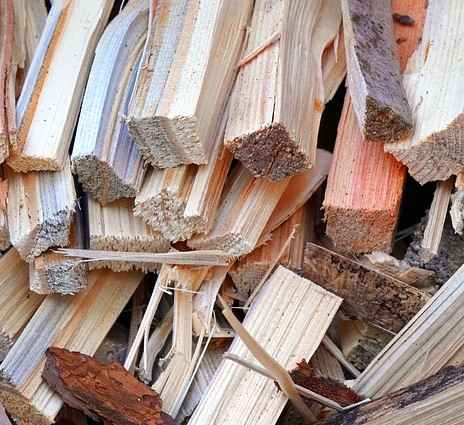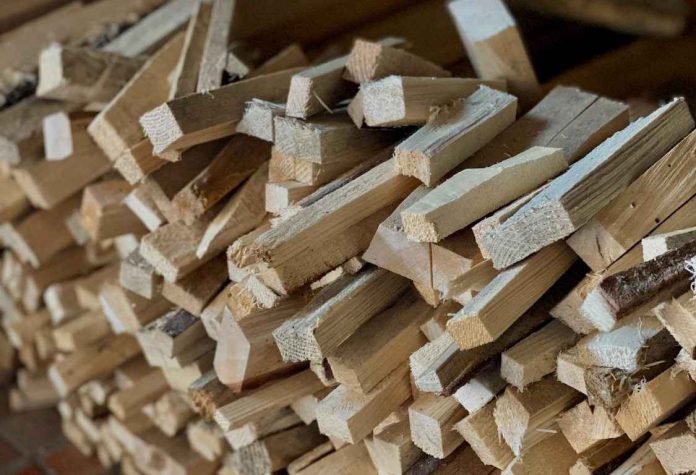While trying to start a fire fast and effectively, choosing the right sort of wood to use as kindling is crucial.
Small, seasoned bits of wood are referred to as kindling and are used to start more extensive logs on the fire.
Whether lighting a fire in your fireplace, wood stove, or even a campfire, selecting the appropriate kindling wood may make a big difference in how well your efforts are realized.
In this article, we will review several crucial elements to consider when selecting the ideal kindling wood, such as the kind of wood, the amount of moisture contained inside the kindling, and the size.
Table of Contents
How to Choose the Perfect Wood for Kindling: A Guide
You must choose the appropriate kindling wood to guarantee that your fire will start up fast and burn brightly.
Because there are so many distinct kinds of wood on the market, it might be difficult to decide which one to purchase.
5 guidelines for choosing the ideal kindling wood for your fireplace

#1. Choose dry wood
The first and most crucial thing to remember when selecting kindling wood is to ensure it is dry. Because of the moisture content of the wood, lighting it will be difficult, and the resulting fire will be smokey and inefficient.
Creosote is a byproduct of the combustion of wet wood, which may be harmful to your chimney if there is a lot of it.
Find wood seasoned for at least six months to a year, which guarantees it is dry enough to use as kindling.
The amount of moisture contained in wood that has been allowed to naturally evaporate due to exposure to air over time is referred to as “seasoned” wood.
If you check for cracks in the end grain of the wood or listen for a hollow sound when you tap two pieces of wood together, you may determine whether or not the wood has been seasoned.
If you do not have access to seasoned wood, you may allow green wood to dry out by keeping it in a dry place with enough ventilation.
Splitting the wood into smaller pieces will increase the surface area of the wood, which in turn will enable it to dry more quickly. This is another way to speed up the drying process.
#2. Choose small, thin pieces
The dimensions of your kindling pieces, including their size and thickness, are also essential. It’s important for kindling to be thin and compact so that it can catch fire readily and rapidly.
Kindling is made up of little bits of wood designed to burn quickly to assist bigger logs in catching fire.
The ideal dimensions for kindling are a thickness comparable to that of your thumb and a length of no more than 12 inches.
A hatchet or an axe may break huge chunks of wood into smaller, more manageable pieces.
#3. Consider local availability
Last but not least, while looking for kindling wood, you should consider the kinds of wood easily accessible in your region.
If you use wood from the area, you may assist in decreasing your carbon impact while also supporting the economy there. Buying wood from a different place may only sometimes be the most cost-effective option.
In certain regions, you may have easier access to particular kinds of wood than others.
For those who reside in an area densely forested with pine trees, for instance, utilizing pine branches as kindling could be the most time- and money-efficient choice.
#4. Choose a softwood
The best kindling to use is often made of softwood. Fires may be started more quickly with flammable softwood than with hardwood.
Because of its greater density and increased ignition delay, hardwood makes an excellent fuel.
Pine, cedar, and spruce are some examples of kindling softwoods. Resinous woods have a high concentration of natural oils and ignition temperature.
#5. Avoid using treated wood
Never use treated wood for the kindling in your fireplace. When treated wood is burned, poisonous vapours are released into the air, harming humans and the environment.
If you burn treated wood in your fireplace or stove, potentially dangerous residues might be left behind.
If you want to know whether or not the wood has been chemically treated, look for a stamp on the end of the piece. It is best to avoid using painted or coloured wood as kindling since this kind of wood may emit harmful vapours.
The Benefits of Using Natural Fire Kindling
Eco-Friendly Fire Kindling
Environmental friendliness is one of the most significant advantages of using natural fire kindling.
Unlike other types of kindling, natural kindling does not produce hazardous compounds or contaminants when burnt. This means that it is healthier and better for the environment.
Many commercial fire starters, for instance, contain compounds that, when ignited, can emit toxic vapours that are hazardous to the environment and your health.
On the other hand, natural fire kindling is produced from renewable resources and is chemical-free.
Natural Fire Kindling is Economical.
Another advantage of using natural fire kindling is its affordability. In contrast to store-bought fire starters, which can be pretty costly, natural fire kindling is frequently free or inexpensive.
This makes it a great option for those on a budget or attempting to save money. Natural firewood is found in various locations, including your yard or a nearby park.
For kindling, you can collect twigs, small branches, and wood sawdust or use wood remnants from a woodworking project.
It’s Simple to Find Natural Fire Kindling
Another advantage of using natural fire kindling is its availability.
Unlike store-bought fire starters, which may necessitate a journey to the store, natural fire kindling can be located in various locations, such as your backyard, local park, or nearby forest.
The collection of natural firewood can also be a family-friendly activity.
You can go on a nature walk to find small branches and twigs for kindling or create a game by accumulating wood flakes from a construction project.
Natural Fire Kindling Is More Real.
Using natural kindling to initiate a fire can provide a more authentic experience.
Using natural fire kindling instead of store-bought fire starters or newspapers, which may feel impersonal and antiseptic, can connect you to the natural world and the history of fire-making.
There is something gratifying about igniting a fire using gathered materials from the earth.
It can also be a wonderful method to connect with nature and appreciate the natural world’s majesty.
Natural Fire Kindling Can Help You Make Fires
The ability to build a fire with natural firewood is enhanced. Practice is required more when using natural kindling than artificial fire starters or newspapers.
Acquiring the skills of kindling, lighting, and maintaining a fire is necessary. Skills in building fires and independence may be improved by using natural firewood.
You’ll have greater confidence when you need to make a fire in the wilderness next time.
Conclusion
Finally, selecting kindling is crucial to starting a fire. Wood shavings, twigs, and tiny branches are eco-friendly, cost-effective, and accurate, and may enhance your fire-making abilities. Natural fire kindling is simple to locate, and access, and a family-friendly pastime. To experience these advantages and connect with nature, use natural fire kindling next time you make a fire.














